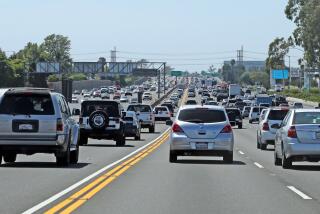Bill Calls for State Agencies to Answer Phones Faster
- Share via
SACRAMENTO — The telephone nightmare: Just about everyone has one.
A simple call to a state agency, meant to take five minutes of a lunch hour, that instead becomes a labyrinthine journey through busy signals, unanswered rings, taped referrals to 800 numbers that put the caller on hold listening to someone else’s music for 20 minutes, waiting for another referral to a number that’s unanswered. . . .
Enough taxpayers shouted, “Enough!” to such bureaucratic unresponsiveness that a state senator decided to place the matter of the unanswered telephone before the Legislature.
Answer in 10 Rings
“I don’t really remember whether it was the Department of Motor Vehicles or Unemployment or what” that was the last straw for an irate constituent, said Sen. Bill Lockyer (D-Hayward). “I’m just trying to get them all to answer their phones.”
Lockyer’s measure, SB2593, is an attempt to require all state agencies to answer their telephones within 10 rings.
“It doesn’t say, ‘Wait until 10,’ ” said Lockyer, asked if perhaps employees who currently leap at the first ring might, under his measure, feel obliged to get in nine rings’ worth of nail-filing time.
Nor does the measure address the maddening busy signal that so frequently greets callers to government agencies. In fact, agency officials worried about complying with the “answer the phone!” measure could get around it by yanking a few lines, so callers would get incessant busy signals instead of incessant ringing.
Can’t Enforce It
“It’s one of those bills you can’t really enforce,” Lockyer acknowledged. “You just try to set a standard, and hope people will live up to it. I mean, how many of these things should we have to put into law?”
So far, two state agencies have registered opposition to Lockyer’s measure. The Board of Equalization worries that some of its smaller branch offices might be hard-pressed to live up to the law at tax time, while officials at the Department of Finance, which handles state budgeting, figure it would cost far too much to try to enforce.
A Finance Department analysis of the measure delivered to Lockyer’s office said that, “assuming a 0.1% staffing increase would be needed” to answer telephones before the 11th ring, the bill would cost the state about $555,000 a year.
Staffing Expensive
Department analyst Kirk Stewart concedes that cost estimate is “speculative,” but shows that “even if (a staffing increase) were very small, it’s costly.”
“It seems to me they’re admitting there’s a problem,” said Matt Newman, an aide to Lockyer.
“The Department of Finance is the office on negativity,” groused Lockyer. “You’d think they’d want people to answer their phones.”
An informal telephone survey revealed that most randomly picked state telephone numbers were answered within five rings. Even the Board of Equalization’s Lakewood and Eureka branch offices answered pleasantly after just one ring.
The Department of Food and Agriculture’s information number rang five times before a tape-recorded message referred callers to other numbers.
Human in 30 Seconds
The notorious Department of Motor Vehicles’ general information line in Sacramento rang twice before a tape recording said all technicians were busy, and just 30 seconds later, a human being answered the phone.
The Department of Health Services’ general information line was busy on the first three tries, but then somebody answered after just two rings.
On that recent day when everyone else in state government seemed to be promptly answering their phones, it was the Cal Vet loan office in south Sacramento that offered the telephone nightmare.
Continual dialing for 15 minutes failed to break through the busy signals. Finally, the line rang twice, responding with a taped referral to an 800 number, which was busy for another 10 minutes. When someone answered, it was to say, “Please hold.”
Twelve minutes, 15 seconds later, a pleasant voice asked, “May I help you?”
More to Read
Sign up for Essential California
The most important California stories and recommendations in your inbox every morning.
You may occasionally receive promotional content from the Los Angeles Times.










